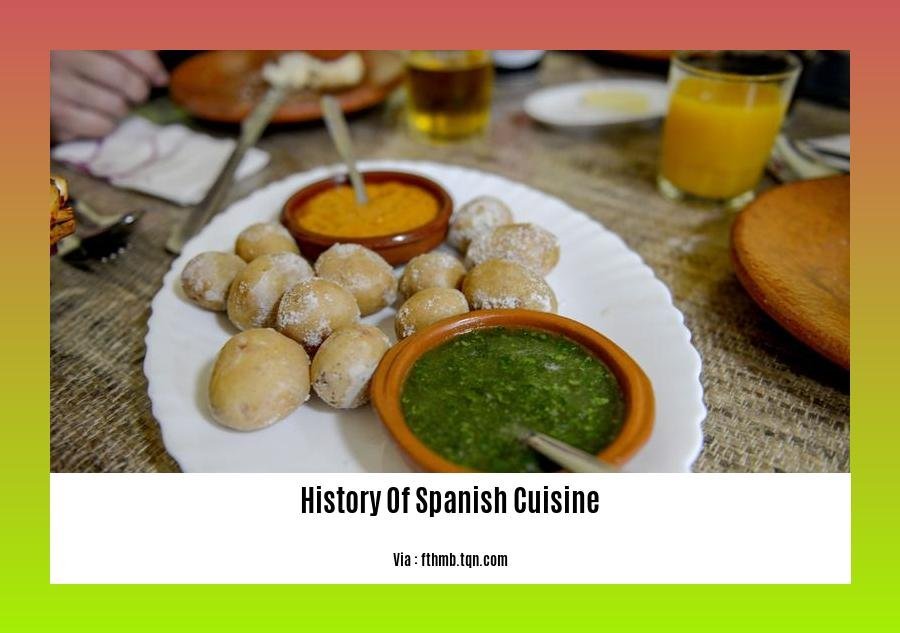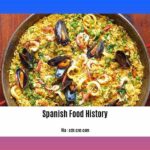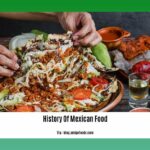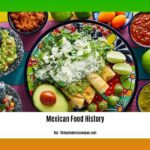Embark on a culinary journey through time as we explore the rich history of Spanish cuisine, a tapestry woven with influences from diverse cultures and civilizations. From the ancient Iberians to the Romans, Moors, and beyond, each era has left its mark on the flavors and traditions that define Spanish gastronomy. Join us as we uncover the stories behind beloved dishes like paella, tapas, and gazpacho, and discover the unique ingredients, techniques, and regional variations that make Spanish cuisine a feast for the senses.
Key Takeaways:
- Spanish cuisine’s history dates back to the 7th century BC.
- The Greeks established contact with Iberia in 1100 BC.
- The Romans arrived in the Iberian Peninsula in 218 BC.
- In 711 AD, descendants of the Berbers from Africa invaded the Peninsula after crossing the Strait of Gibraltar.
- Spain’s colonization of the New World brought revolutionary changes to Spanish cuisine and the rest of Europe.
- The Romans and Arabs, who occupied Spain for 800 years, made significant contributions to Spanish cuisine.
- Spanish cuisine was also shaped by European and American influences, adapted to Spanish tastes.
History of Spanish Cuisine
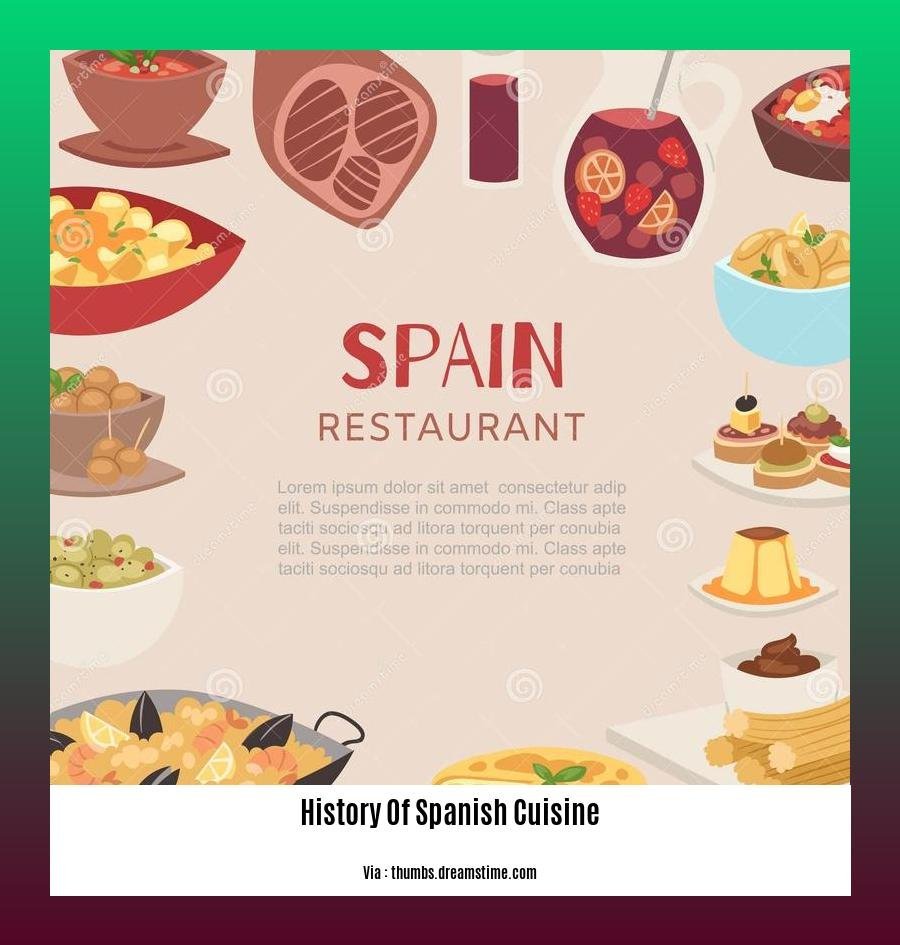
Spanish cuisine, a symphony of flavors and aromas, is a captivating story of cultural convergence and culinary evolution. From the ancient Romans and Arabs to the New World’s indigenous communities, Spain’s rich history has left an indelible mark on its cuisine, creating a vibrant tapestry of culinary traditions.
Ancient Influences
The roots of Spanish cuisine can be traced back to the 7th century BC, when the Greeks established contact with the Iberian Peninsula, introducing new ingredients and cooking techniques. Over time, the Romans arrived, bringing with them their love of wine, olive oil, and garum, a fermented fish sauce that would become a staple in Spanish cooking.
Arabian Delights
In the 8th century AD, the arrival of the Moors from North Africa marked a transformative era for Spanish cuisine. The Arabs introduced a wealth of new ingredients, including rice, citrus fruits, almonds, and spices like saffron and cumin, forever changing the culinary landscape of Spain. Dishes like paella, a saffron-infused rice dish with seafood and vegetables, and gazpacho, a chilled tomato soup, are testaments to this vibrant fusion of cultures.
The New World’s Influence
Spain’s colonization of the Americas had a profound impact on its cuisine. New ingredients like tomatoes, potatoes, and chili peppers made their way back to Spain, revolutionizing traditional dishes. The exchange of ingredients between the Old and New Worlds gave birth to many iconic Spanish dishes, including patatas bravas, a spicy potato dish, and escalivada, a roasted vegetable dish.
A Culinary Melting Pot
Over the centuries, Spanish cuisine continued to evolve, influenced by European and American trends. French techniques, such as the use of sauces and elaborate presentations, made their mark on Spanish haute cuisine. American influences, like the introduction of fast food and the rise of the tapas culture, further diversified Spain’s culinary landscape.
Today, Spanish cuisine stands as a testament to its rich history. It’s a cuisine that celebrates diversity, where flavors from different cultures blend harmoniously to create a culinary experience that is uniquely Spanish.
For a delicious journey through time, explore the history of shepherd’s pie, a culinary classic born from humble beginnings.
Embark on a delectable adventure as we delve into the history of Spanish cuisine, a vibrant tapestry of flavors and traditions.
The Discovery of the Americas: The voyages of Christopher Columbus and other Spanish explorers brought an influx of new ingredients and culinary influences from the Americas, including tomatoes, potatoes, and chili peppers, which transformed Spanish cuisine.
Culinary adventurers, prepare to embark on a voyage of flavors as we delve into the transformative era when the Americas met Spain.
Picture this: fearless explorers like Christopher Columbus, their hearts ablaze with wanderlust, set sail from Spain, venturing into the vast expanse of the Atlantic. Their mission? To discover a new route to Asia, little did they know that their journey would rewrite the culinary history of Spain.
Upon reaching the shores of the Americas, these intrepid explorers encountered a wealth of exotic ingredients and culinary techniques that would forever alter the Spanish kitchen. Tomatoes, with their vibrant red hue and tangy flavor, became the stars of many Spanish dishes, adding a burst of color and brightness to traditional recipes.
Potatoes, humble yet versatile, found their way into hearty stews, soups, and savory tapas, becoming a staple ingredient in Spanish cuisine.
Chili peppers, with their fiery kick, brought a new dimension of flavor to Spanish dishes, adding depth and a touch of heat to traditional recipes.
The arrival of these new ingredients sparked a culinary revolution in Spain. Spanish chefs eagerly experimented with these exotic flavors, blending them seamlessly with their own culinary traditions to create innovative and delicious dishes that would become the foundation of modern Spanish cuisine.
Key Takeaways:
Christopher Columbus’s voyages to the Americas opened up a gateway for the exchange of ingredients and culinary influences between the two continents.
Tomatoes, potatoes, and chili peppers, among other ingredients, were introduced to Spain from the Americas, revolutionizing Spanish cuisine.
The fusion of these new ingredients with traditional Spanish cooking techniques resulted in the creation of innovative and flavorful dishes.
This culinary exchange had a profound impact on Spanish cuisine, shaping its identity and transforming it into the diverse and vibrant cuisine we know today.
Sources:
The Rise of Regional Cuisines: Spain is home to a diverse array of regional cuisines, each with its own unique flavors and specialties, influenced by geography, history, and local produce.
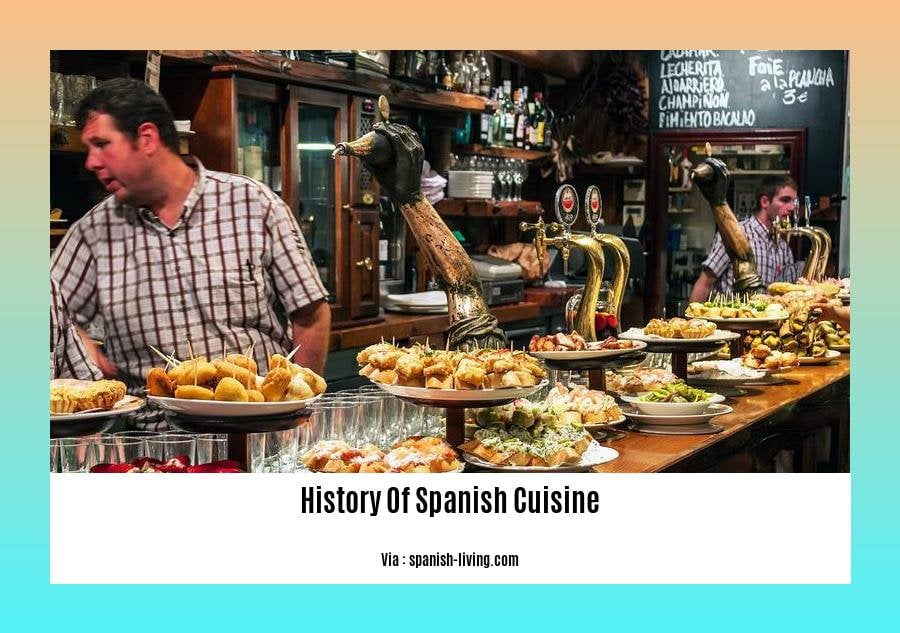
Friends, let’s jump into the culinary adventure that is Spain, a country that wears flavor like a crown! Spain is a vibrant culinary tapestry woven from regional cuisines, each with its own charm and history.
Geography, history, and local ingredients have played a tantalizing tango in the evolution of Spanish gastronomy. Take the south, fierce and fiery Andalusia, with its Moorish influences. Tapas, gazpacho, and salmorejo are just a few stars of the show.
In the northeast, we find Catalonia, where paella reigns supreme, alongside the hearty escudella i carn d’olla and the sweet, creamy crema catalana.
Moving north, the Basque country is a seafood paradise. Pintxos, those miniature wonders, explode with flavor, while marmitako, a fish stew, warms the soul and Basque cheesecake is a dreamy finale.
Up in the northwest, Galicia beckons with its seafood stews and octopus dishes, while in the interior, Castilian cuisine offers hearty comfort with roast suckling pig, cocido madrileño, and sopa castellana.
Spanish cuisine is an ode to diversity: the coasts whisper of seafood, the mountains sing of stews, and the east brings rice to the party. And let’s not forget that golden elixir, olive oil, Spain is its proud producer and uses it like a culinary magic wand.
Key Takeaways:
Geography and History:
- Spain’s diverse regional cuisines are shaped by geography, history, and local produce.
- Southern regions, like Andalusia, bear the mark of Moorish influences, while northern cuisines, like Basque and Galician, showcase their unique seafood treasures.
Coastal and Interior Flavors:
- Coastal regions excel in seafood dishes, while the interior offers hearty stews and roasted meats.
- Paella, a symbol of Catalan cuisine, is a delightful rice dish with seafood or meat.
- Basque pintxos, miniature culinary masterpieces, burst with flavor and creativity.
- Galician seafood stews and octopus dishes are a testament to the region’s bountiful coastline.
- Castilian cuisine, in the heart of Spain, offers hearty dishes like roast suckling pig and cocido madrileño.
Olive Oil:
- Spain is the world’s largest producer of olive oil, and it plays a crucial role in Spanish cuisine.
- Olive oil adds flavor and depth to dishes, from simple salads to hearty stews.
Sources:
– Spain’s Food and the 6 Different Culinary Regions – The Spruce Eats
– What to Eat in Spain – 15 Spanish Foods You Must Try – Local Adventurer
Modern Spanish Cuisine: In recent decades, Spanish cuisine has undergone a culinary renaissance, with chefs embracing traditional ingredients and techniques while incorporating modern culinary innovations, leading to the global recognition and acclaim of Spanish gastronomy.
Key Takeaways:
- Modern Spanish cuisine blends traditional and modern techniques, creating innovative dishes that captivate the culinary world.
- Famed chefs like Ferran Adrià and the Roca brothers have revolutionized Spanish gastronomy, earning international accolades.
- Spanish chefs emphasize quality ingredients, sustainability, and unique flavors, resulting in a culinary experience that is both delicious and thought-provoking.
In recent decades, Spanish cuisine has undergone a remarkable transformation, captivating the culinary world with its innovative dishes and techniques. This renaissance has been spearheaded by renowned chefs like Ferran Adrià and the Roca brothers, who have pushed the boundaries of gastronomy, earning international accolades and recognition for Spain’s culinary prowess.
At the heart of modern Spanish cuisine lies a deep respect for tradition. Chefs draw inspiration from Spain’s rich culinary heritage, utilizing time-honored techniques and locally sourced ingredients to create dishes that are both authentic and innovative. They embrace the country’s diverse regional cuisines, incorporating flavors and influences from across the Iberian Peninsula.
One of the hallmarks of modern Spanish cuisine is its focus on quality ingredients. Chefs seek out the finest produce, seafood, and meats, often working closely with local farmers and fishermen to ensure the freshest and most flavorful ingredients. Sustainability is also a key consideration, with chefs committed to using eco-friendly practices and reducing food waste.
Another defining characteristic of modern Spanish cuisine is its emphasis on unique flavors. Chefs experiment with bold combinations and unexpected textures, creating dishes that are both visually stunning and palate-pleasing. They incorporate spices and herbs from around the world, blending them with traditional Spanish ingredients to create dishes that are truly unique and memorable.
The result of this culinary transformation is a vibrant and dynamic cuisine that celebrates Spain’s rich culinary heritage while embracing modern innovations. Spanish chefs are at the forefront of the culinary world, pushing the boundaries of gastronomy and creating dishes that captivate the senses and leave a lasting impression.
Relevant URL Sources:
- Gastronomy as Art: The Cultural Essence of Spanish Cuisine
- The Future of Spanish Gastronomy – EL PAÍS English Edition
FAQ
Q1: How did the Roman and Arab occupations influence Spanish cuisine?
A1: The Romans and Arabs, who occupied Spain for 800 years, made significant contributions to Spanish cuisine. The Romans introduced new agricultural techniques, such as irrigation, and crops, such as wheat, grapes, and olives. They also introduced new cooking methods, such as frying and stewing. The Arabs introduced new spices and ingredients, such as saffron, cumin, and eggplant. They also introduced new cooking techniques, such as slow cooking and the use of tagines.
Q2: What was the impact of the Spanish colonization of the New World on Spanish cuisine?
A2: Spain’s colonization of the New World brought revolutionary changes to Spanish cuisine, as well as the rest of Europe. New ingredients, such as tomatoes, potatoes, peppers, and chocolate, were introduced to Spain from the Americas. These ingredients had a profound impact on Spanish cuisine, and they are now essential to many traditional Spanish dishes.
Q3: What are some of the most popular regional cuisines in Spain?
A3: Spain is renowned for its diverse and delicious regional cuisines, each with its unique flavors, ingredients, and cooking methods. Some of the most popular regional cuisines in Spain include Andalusian cuisine, Catalan cuisine, Basque cuisine, Galician cuisine, and Castilian cuisine.
Q4: What are some of the most common dishes in Spanish cuisine?
A4: Several dishes are common throughout Spain, such as paella, tapas, and churros. Paella is a rice dish that is typically made with seafood, chicken, and vegetables. Tapas are small plates of food that are served as appetizers or snacks. Churros are fried dough pastries that are often served with chocolate sauce.
Q5: What are some of the most famous Spanish chefs?
A5: Modern Spanish Cuisine is influenced by famed chefs like Ferran Adrià, who revolutionized the culinary landscape of Spain. Renowned chefs such as the Roca brothers, Andoni Luis Aduriz, Carme Ruscalleda, Sergi Arola, Daviz Muñoz, Paco Roncero, Elena Arzak, Eneko Atxa, Susi Díaz, and many more have risen to prominence, contributing to the legacy of Spanish gastronomy.
- Senior at What Age: Benefits & Eligibility Guide - March 29, 2025
- Unlocking Senior Benefits: How Old is a Senior? Your Complete Guide - March 29, 2025
- Master Russian Politeness:A Guide to Saying Please - March 29, 2025
